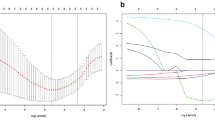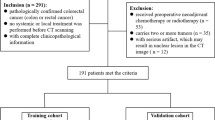Abstract
Background and purpose
The pre-surgical estimation of lymph node (LN) metastasis in colorectal cancer (CRC) poses a significant diagnostic predicament. The associations between LN morphology, density, and metabolic heterogeneity and LN metastasis status in CRCs have been seldomly examined through the lens of radiomics. This research aimed to assess 2-[18F]FDG PET-based quantification of intratumoral metabolic heterogeneity for predicting lymph node metastasis in patients with colorectal cancer.
Materials and methods
The construction of the model utilized data from 264 CRC patients, all of whom underwent preoperative 2-[18F]FDG PET/CT. Radiomic features were extracted from PET and CT images of LNs. Least absolute shrinkage and selection operator (LASSO) regression was implemented for selecting pertinent imaging features with a tenfold cross-validation. The predictive accuracy for LN metastasis status was juxtaposed against traditional methodologies (comprising CT-reported LN status and PET/CT-reported LN status) by deploying the receiver operating characteristic (ROC) curve analysis. The radiomics signature was evaluated based on discrimination, calibration, and clinical utility parameters. The model was further subjected to validation using an independent cohort of 132 patients from the period of January 2012 to June 2020.
Results
The radiomics model was composed of eight significant radiomic features (five from PET and three from CT), encapsulating metabolic and density heterogeneity. The radiomics signature (area under the curve (AUC), 0.908) showcased a significantly superior performance compared to CT-reported LN status (AUC, 0.563, P < 0.001) and PET/CT-reported LN status (AUC, 0.64, P < 0.001) for predicting LN-positive or LN-negative status. The radiomics signature (AUC, 0.885) also showcased a significantly superior performance compared to CT-reported LN status (AUC, 0.587, P < 0.001) and PET/CT-reported LN status (AUC, 0.621, P < 0.001) to identify N1 and N2. This signature maintained its independence from clinical risk factors and exhibited robustness in the validation test set. Decision curve analysis attested to the clinical utility of the radiomics signature.
Conclusions
The radiomics signature based on 2-[18F]FDG PET/CT, which derived image features directly from LNs irrespective of clinical risk factors, displayed enhanced diagnostic performance compared to conventional CT or PET/CT-reported LN status. This allows for the identification of pre-surgical LN metastasis status and facilitates a patient-specific prediction of LN metastasis status in CRC patients.





Similar content being viewed by others
Data availability
For data availability, interested parties may request the data from the corresponding author.
References
Siegel RL, Miller KD, Goding Sauer A, Fedewa SA, Butterly LF, Anderson JC, et al. Colorectal cancer statistics, 2020. CA Cancer J Clin. 2020;70:145–64. https://doi.org/10.3322/caac.21601.
Engstrom PF, Arnoletti JP, Benson AB 3rd, Chen YJ, Choti MA, Cooper HS, et al. NCCN Clinical Practice Guidelines in Oncology: colon cancer. J Natl Compr Canc Netw. 2009;7:778–831. https://doi.org/10.6004/jnccn.2009.0056.
Smith AJ, Driman DK, Spithoff K, Hunter A, McLeod RS, Simunovic M, et al. Guideline for optimization of colorectal cancer surgery and pathology. J Surg Oncol. 2010;101:5–12. https://doi.org/10.1002/jso.21395.
Dighe S, Purkayastha S, Swift I, Tekkis PP, Darzi A, A’Hern R, et al. Diagnostic precision of CT in local staging of colon cancers: a meta-analysis. Clin Radiol. 2010;65:708–19. https://doi.org/10.1016/j.crad.2010.01.024.
Bipat S, Glas AS, Slors FJ, Zwinderman AH, Bossuyt PM, Stoker J. Rectal cancer: local staging and assessment of lymph node involvement with endoluminal US, CT, and MR imaging–a meta-analysis. Radiology. 2004;232:773–83. https://doi.org/10.1148/radiol.2323031368.
Townsend DW, Carney JP, Yap JT, Hall NC. PET/CT today and tomorrow. J Nucl Med. 2004;45(Suppl 1):4S-14S.
Hatt M, Tixier F, Pierce L, Kinahan PE, Le Rest CC, Visvikis D. Characterization of PET/CT images using texture analysis: the past, the present... any future? Eur J Nucl Med Mol Imaging. 2017;44:151–65. https://doi.org/10.1007/s00259-016-3427-0.
Campbell PJ, Yachida S, Mudie LJ, Stephens PJ, Pleasance ED, Stebbings LA, et al. The patterns and dynamics of genomic instability in metastatic pancreatic cancer. Nature. 2010;467:1109–13. https://doi.org/10.1038/nature09460.
Lambin P, Rios-Velazquez E, Leijenaar R, Carvalho S, van Stiphout RG, Granton P, et al. Radiomics: extracting more information from medical images using advanced feature analysis. Eur J Cancer. 2012;48:441–6. https://doi.org/10.1016/j.ejca.2011.11.036.
Lee JW, Lee SM. Radiomics in oncological PET/CT: clinical applications. Nucl Med Mol Imaging. 2018;52:170–89. https://doi.org/10.1007/s13139-017-0500-y.
Aerts HJ, Velazquez ER, Leijenaar RT, Parmar C, Grossmann P, Carvalho S, et al. Decoding tumour phenotype by noninvasive imaging using a quantitative radiomics approach. Nat Commun. 2014;5:4006. https://doi.org/10.1038/ncomms5006.
Huang YQ, Liang CH, He L, Tian J, Liang CS, Chen X, et al. Development and validation of a radiomics nomogram for preoperative prediction of lymph node metastasis in colorectal cancer. J Clin Oncol. 2016;34:2157–64. https://doi.org/10.1200/JCO.2015.65.9128.
Wu S, Zheng J, Li Y, Yu H, Shi S, Xie W, et al. A radiomics nomogram for the preoperative prediction of lymph node metastasis in bladder cancer. Clin Cancer Res. 2017;23:6904–11. https://doi.org/10.1158/1078-0432.CCR-17-1510.
Chan KC, Perucho JAU, Subramaniam RM, Lee EYP. Utility of pre-treatment 18 F-fluorodeoxyglucose PET radiomic analysis in assessing nodal involvement in cervical cancer. Nucl Med Commun. 2023;44:375–80. https://doi.org/10.1097/MNM.0000000000001672.
Onner H, Coskun N, Erol M, Eren Karanis MI. The role of histogram-based textural analysis of (18)F-FDG PET/CT in evaluating tumor heterogeneity and predicting the prognosis of invasive lung adenocarcinoma. Mol Imaging Radionucl Ther. 2022;31:33–41. https://doi.org/10.4274/mirt.galenos.2021.79037.
Soydal C, Varli B, Araz M, Bakirarar B, Taskin S, Ortac UF. Radiomics analysis of uterine tumors in 18F-fluorodeoxyglucose positron emission tomography for prediction of lymph node metastases in endometrial carcinoma. Turk J Med Sci. 2022;52:762–9. https://doi.org/10.55730/1300-0144.5371.
Liu W, Qiao X, Ge H, Zhang S, Sun X, Li J, et al. Recurrence patterns are significantly associated with the (18)F-FDG PET/CT radiomic features of patients with locally advanced non-small cell lung cancer treated with chemoradiotherapy. Oncol Lett. 2023;26:317. https://doi.org/10.3892/ol.2023.13903.
Abenavoli EM, Barbetti M, Linguanti F, Mungai F, Nassi L, Puccini B, et al. Characterization of mediastinal bulky lymphomas with FDG-PET-based radiomics and machine learning techniques. Cancers (Basel). 2023;15. https://doi.org/10.3390/cancers15071931.
Dai M, Wang N, Zhao X, Zhang J, Zhang Z, Zhang J, et al. Value of presurgical (18)F-FDG PET/CT radiomics for predicting mediastinal lymph node metastasis in patients with lung adenocarcinoma. Cancer Biother Radiopharm. 2022. https://doi.org/10.1089/cbr.2022.0038.
Nerad E, Lahaye MJ, Maas M, Nelemans P, Bakers FC, Beets GL, et al. Diagnostic accuracy of CT for local staging of colon cancer: a systematic review and meta-analysis. AJR Am J Roentgenol. 2016;207:984–95. https://doi.org/10.2214/AJR.15.15785.
Kim JY, Park JE, Jo Y, Shim WH, Nam SJ, Kim JH, et al. Incorporating diffusion- and perfusion-weighted MRI into a radiomics model improves diagnostic performance for pseudoprogression in glioblastoma patients. Neuro Oncol. 2019;21:404–14. https://doi.org/10.1093/neuonc/noy133.
Ceriani L, Milan L, Virili C, Cascione L, Paone G, Trimboli P, et al. Radiomics analysis of [(18)F]-fluorodeoxyglucose-avid thyroid incidentalomas improves risk stratification and selection for clinical assessment. Thyroid. 2020. https://doi.org/10.1089/thy.2020.0224.
Simpson G, Spieler B, Dogan N, Portelance L, Mellon EA, Kwon D, et al. Predictive value of 0.35 T magnetic resonance imaging radiomic features in stereotactic ablative body radiotherapy of pancreatic cancer: a pilot study. Med Phys. 2020;47:3682–90. https://doi.org/10.1002/mp.14200.
Shen X, Yang F, Yang P, Yang M, Xu L, Zhuo J, et al. A contrast-enhanced computed tomography based radiomics approach for preoperative differentiation of pancreatic cystic neoplasm subtypes: a feasibility study. Front Oncol. 2020;10:248. https://doi.org/10.3389/fonc.2020.00248.
Reinert CP, Baumgartner K, Hepp T, Bitzer M, Horger M. Complementary role of computed tomography texture analysis for differentiation of pancreatic ductal adenocarcinoma from pancreatic neuroendocrine tumors in the portal-venous enhancement phase. Abdom Radiol (NY). 2020;45:750–8. https://doi.org/10.1007/s00261-020-02406-9.
Vickers AJ, Cronin AM, Elkin EB, Gonen M. Extensions to decision curve analysis, a novel method for evaluating diagnostic tests, prediction models and molecular markers. BMC Med Inform Decis Mak. 2008;8:53. https://doi.org/10.1186/1472-6947-8-53.
Cook GJR, Siddique M, Taylor BP, et al. Radiomics in PET: principles and applications. Clin Transl Imaging. 2014;2:269–76. https://doi.org/10.1007/s40336-014-0064-0.
Funding
The study received support from the National Natural Science Foundation of China (No. 92259103, 82171972), the Clinical Research Project of Health Industry of Shanghai Municipal Health Commission (20214Y0438), and the Nurture projects for the Youth Medical Talents-Medical Imaging Practitioners Program (SHWRS(2021)_099).
Author information
Authors and Affiliations
Corresponding authors
Ethics declarations
Ethical approval
Ethical approval was obtained for the study involving human participants, and it adhered to the principles outlined by the ethics committee at Renji Hospital and the Declaration of Helsinki from 1964. Animal-based research was not part of this study.
Consent to participate
Informed consent was obtained from all participants prior to conducting the examination.
Consent for publication
Not applicable.
Competing interests
The authors declare no competing interests.
Additional information
Publisher's Note
Springer Nature remains neutral with regard to jurisdictional claims in published maps and institutional affiliations.
Supplementary Information
Below is the link to the electronic supplementary material.
Rights and permissions
Springer Nature or its licensor (e.g. a society or other partner) holds exclusive rights to this article under a publishing agreement with the author(s) or other rightsholder(s); author self-archiving of the accepted manuscript version of this article is solely governed by the terms of such publishing agreement and applicable law.
About this article
Cite this article
Xu, L., Huang, G., Wang, Y. et al. 2-[18F]FDG PET-based quantification of lymph node metabolic heterogeneity for predicting lymph node metastasis in patients with colorectal cancer. Eur J Nucl Med Mol Imaging 51, 1729–1740 (2024). https://doi.org/10.1007/s00259-023-06578-6
Received:
Accepted:
Published:
Issue Date:
DOI: https://doi.org/10.1007/s00259-023-06578-6




